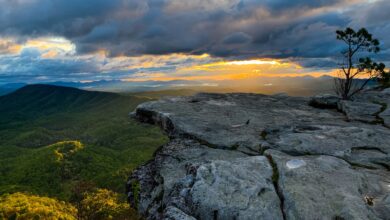The Top 9 Best Backpacking Tents for Hiking and Camping
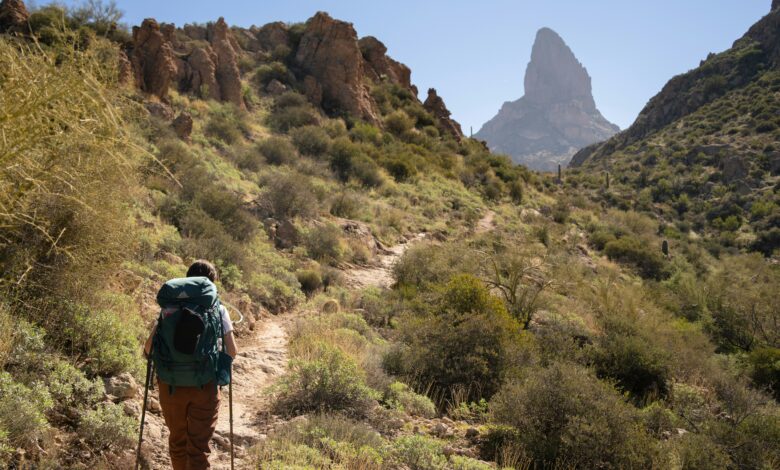
Just because you are out in the wilderness enjoying the raw beauty of nature, doesn’t mean that you don’t need a good night’s rest. That brings us to the most crucial element in your outdoor kit, the backpacking tent.
Picking the best backpacking tent requires considering the entire picture while balancing the advantages and shortcomings of different models. In my experience, focusing on one particular aspect while evaluating performance can lead to dissatisfaction in the long run.
We tested some of the best backpacking tents to list out nine top options that meet our approval. In addition, we zoom in on the factors that will help in making the buying process easier for you.
How We Tested
Our goal is to provide honest and unbiased reviews to the readers and recommend only those products that perform well in real-world scenarios. We started with 14 tents from different categories and evaluated them through in-person testing. Some of these tents were already in our collection, while others were purchased for testing.
Each of these tents was tested in at least two trips by a team of four testers, including yours truly. Based on their performance, we judged the tents in terms of durability, weather-proofing, weight, comfort, price, and ease of set up. Special thanks to Finn, the golden retriever of one of our reviewers, for helping us evaluate some of these details.
For an outdoor addict like me, testing out different tents is a fun task. But that doesn’t make it free from some unique challenges. For instance, when a tent couldn’t be tested in actual rain, we conducted an in-house hose test to check its waterproofing performance. At the same time, we took feedback from multiple backpackers about their experience with these backpacking tents.
Finally, the batch of 14 tents was whittled down to this list of nine best backpacking tents.
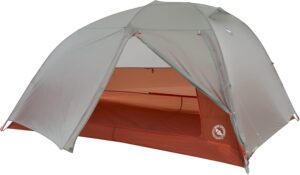
1. Big Agnes Copper Spur HV
Best Overall
When it comes to offering a reliable design without any significant compromises, the Big Agnes Copper Spur HV UL2 emerges as one of our favorite freestanding backpacking tents.
Coming from the ultralight stable, the total weight of the Copper Spur is just above 3 lbs. What impressed me most was the high space-to-weight ratio. 29 sq ft of floor area and 40 inches of headroom are large enough for spreading out two large sleeping pads.
Add to that the dual vestibule areas of 9 sq ft each, and you get sufficient space for storing two 60L backpacks and other medium-sized gear like rain jackets and camping axes. Plus, there are additional side pockets for storage. I find the mtnGLO LED tent light technology a handy feature to have, especially for reading in the tent.
Setting up the Copper Spur using the color-coded poles and grommets is super easy. The fly comes with pre-cut guylines and tensioners, and there are buckle clips to secure the corners with the right amount of tension.
The double ripstop mixed denier fabric of the fly and the floor is stronger than it feels and shows no signs of damage after two consecutive multi-day hikes. Admittedly, the DAC Featherlite NFL poles aren’t the toughest options out there. Handle them with care and they will last long.
During a hike around Mount Rainier, we faced some strong winds and moderate rain. Even so, the Copper Spur kept us comfortable and bone dry.
Not that it is without downsides. If you’re hard on your gear, this may not be the right choice for you. Besides, the premium price point doesn’t make it a budget-friendly option either.
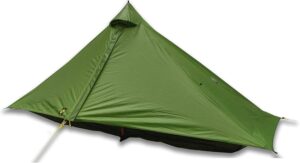
2. Six Moon Designs Lunar Solo
Best One-Person Tent
The Lunar Solo is a pyramid-type tent with spacious interiors and a no-frills design. While this lightweight tent comes with some trade-offs, some of us would prefer a bare-bones hiking tent to shave any extra weight.
With over 26 sq ft of area, there is enough room for taller individuals to stretch out comfortably after a long day and find space for gear as well. You can use the extra guy-line points at both ends to stretch the tenant wall for more breathing space. However, the steepness of the sidewalls reduces the headroom.
The Lunar Solo packs small and weighs 26 oz only. Add to that the weight of a pole and some stakes, and you get a combined weight of 32-35 oz. The excellent packability makes this not just a great tent for backpacking but for bike trips too.
This tent’s ability to shed rain is nothing but impressive. The SilyPoly material has a hydrostatic head of 3,000mm, which offers good rain protection. The 40D weave used in the floor fabric makes it more durable than many of the competitors.
I would suggest switching the ultralight tent poles from Six Moon Designs to something more beefy. I set it up with my trekking pole with the sloped end facing the wind, and it worked great.
Now, getting used to the process of setting it up will take some trial and error. I was left scratching my head a few times, especially when the ground was not so even. Taking a look at the tent pitching advice provided by Six Moon is a good idea.
With single-walled tents, some condensation is inevitable on humid nights. With sustained rain, you need to keep a towel at hand to prevent the water from dripping. For summer backpacking, this shouldn’t be an issue.
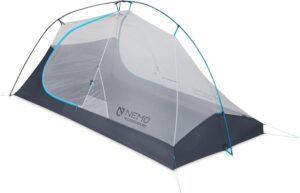
3. NEMO Hornet Elite OSMO 2P
Best Ultralight Backpacking Tent
With a packed weight of 1 lb 13 oz, the Hornet Elite is a genuinely ultralight two-walled tent ideal for longer backpacking trips. But then, it’s best for backpackers who handle their gear with care.
Made from recycled materials, the proprietary OSMO poly-nylon ripstop fabric is highly water-repellent, resulting in the tent’s reliable wet-weather performance. Kudos to Nemo’s commitment to sustainability and the use of PFAS-free materials.
There are a few thoughtful design features, like dual doors, vestibules with door tie-backs, and a bathtub floor. The mesh-heavy construction ensures excellent ventilation, no matter the weather conditions.
The Y-shaped pole structure and color-coded webbings make the tent easy to set up. That said, the wind resistance isn’t great due to the limited number of poles – a downside of the lightweight design. Gale-force winds can push the sides into the interiors. Even so, I had no problem sleeping in this tent with the wind gusting at 30-35 MPH.
With a floor area of 21.8 sq ft and a vestibule area of 6.9 sq ft, the Hornet Elite isn’t the most spacious option. It will be a tight squeeze for two adults over 6 feet. On the plus side, the near-vertical walls and 39 inches of peak height help in making it feel roomy.
Durability is one area where you need to be careful with the Hornet Elite, especially if you have a pet. Nemo doesn’t mention the denier (D) rating of the fabric, and the fly and the tent floor are vulnerable to punctures. On the plus side, Nemo offers a lifetime warranty on the Hornet Elite.
To sum up, the Hornet Elite is a great option if you don’t mind sacrificing interior space to save weight. It will serve you as the best lightweight backpacking tent, as long as you understand its strengths and weaknesses.
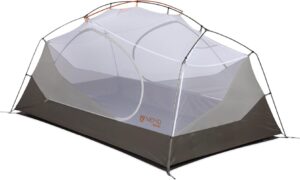
4. NEMO Aurora 2
Best Bang for Your Buck
When I first used the Aurora, I was blown away by how spacious the interiors were. With a floor area of 32.4 sq ft, dual vestibules of 9.2 sq ft each, and large doors, the Aurora feels almost like a cabin. Add to that the vertical walls that ensure enough space for two adults and a pet.
Even with an affordable price tag, Nemo packs a lot of practical features in the Aurora. The outer material offers great weather resistance, and the Aurora kept me dry during two wet nights in the Olympic National Park. While it’s great for forested areas, the Aurora is stable enough to withstand wind gusts.
Setting up the tent is painless, and the intuitive design helps. The freestanding design comes with two poles, and there are four guylines for additional stability. The breakdown speed is between 4-5 minutes.
The durability of the 68D polyester fabric is impressive. Plus, Nemo adds a good-quality footprint that is built to last. The poles are significantly thicker and sturdier than those in typical ultralight tents.
You will have no complaints about the ventilation, thanks to the generous use of mesh. The interiors have thoughtful additions like gear pockets and overhead nightlight pockets.
The compromise with the Aurora comes in the form of the extra weight. The packed weight of the Aurora is 5 lb 10 oz, which makes it heavy. You can’t classify it as a purebred ultralight backpacking tent. Even so, if you’re looking for a budget-friendly backpacking tent that also works great as a camping tent, the Aurora is a solid choice.
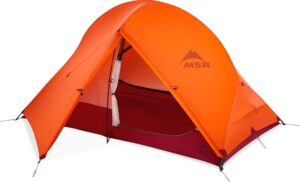
5. MSR Access 2
Best All-Season Backpacking Tent
Among a crowd of 4-season tents, the MSR Access 2 stands out with its versatility and top-notch features. While it’s built to withstand snow conditions, the tent is fairly breathable in warm conditions – an area where many 4-season tents perform poorly.
The overall quality is nothing short of impressive. The tent body is 20D ripstop nylon, and the canopy comes with a DWR finish. The Easton Syclone poles, made from special composite materials, can bend while withstanding strong gusts and snow loading, without snapping.
The 29 sq ft of interior space, plus 17.5 sq. ft of generous vestibule space, is spacious enough for two people and gear. There are two doors and two vestibules for convenience, and two large mesh pockets provide additional storage space. One thing I miss is the presence of an overhead pocket.
In theory, the 1200 mm hydrostatic head rating for the fly sheet sounds somewhat underwhelming. Even so, the tent showed no signs of water seepage in the 15-minute medium-pressure hose test that we performed.
While the overall quality and design is top-notch, there’s a chink in the Aceess 2’s armor. The rainfly doesn’t extend to the ground level. At times, this small gap allows the spindrift to enter the tent in snowy conditions.
Striking a balance between ventilation and cold-weather resistance is tough, and the Access 2 performs fairly well. However, on a clear sunny day in the snow, the nylon body traps heat and gets stuffy. The best option is to keep the door open to assist in ventilation.
The packed weight of 4 lb 1 ounce makes the Access 2 a relatively lightweight 4-season tent. Setup and takedown are fuss-free, and the connected poles make it easier to create the support structure.
All in all, the Access 2 has enough going for it to be a reliable choice for ski touring in snowy conditions.
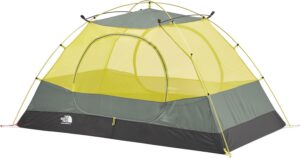
6. The North Face Stormbreak 2
The North Face Stormbreak 2 is a solid offering in the budget backpacking tent category. With a durable 75D polyester canopy and flooring, twin doors and vestibules, and an easy setup process, the Stormbreak ticks all the right boxes and then tops them with a high livability level.
One of the most spacious tents in this category, the Stormbreak has 30.56 sq ft of interior space. Considering the almost vertical walls and adequate headroom, this isn’t a tent that will make you feel sandwiched inside, even with two occupants.
With a trail weight of 5 lbs 5 oz, the Stormbreak isn’t the most lightweight option. On the plus side, the performance as a 3-season tent is great. The outer fabric has a non-PFC DWR finish that keeps rainwater out during a thunderstorm.
A solo backpacker can set up this tent within 10 minutes. We faced no issues with the breakdown process either. The Stormbreak has four interior pockets for organizing gear – a useful addition. High and low ventilation points work well, and generous amounts of mesh allow free air movement.
The Stormbreak served our team well during the warm nights on a trip to the Paria Canyon. With the reinforced guy points, the tent structure feels solid and can handle moderate winds without breaking a sweat.
Even though the North Face Stormbreak 2 doesn’t break any new ground in terms of innovation, it’s a workhorse aimed at hikers with a modest budget.
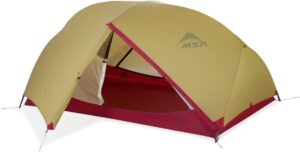
7. MSR Hubba Hubba 2-Person
The Hubba Hubba series is among the best-selling tents from MSR, and a lot has been said about it. After over a year of use, I find the Hubba Hubba a great combination of high-end build and thoughtful design. For the average weekend backpacker, the tent is a great investment.
At 29 sq ft of interior space, it’s good enough for two people. You get 40 inches of headroom and large vestibules that provide an additional storage space of around 15 sq ft.
The use of flexible Easton Syclone poles and a DuroShield PU-coated exterior makes this a reliable tent in foul weather conditions. I have tested the Hubba Hubba in sunny weather as well as in wet conditions, and the performance was always on the mark.
Strong gusts on an open desert floor didn’t seem to bother its freestanding structure either. To its credit, the Hubba Hubba can handle occasional snow loading on a spring trail.
Beyond that, the 20D ripstop nylon fabric for the floor isn’t the most durable. However, the Hubba Hubba has held on well during a year of rough use. At 2 lbs.14 oz, it is ridiculously lighter than some of its competitors.
Setup is easy and fast, and I had no problems pitching the tent even in high winds. The ventilation is good, thanks to the high micromesh-covered area and deployable vents on the rainfly. Still, considering the price tag, having to buy a footprint separately is a downer.
The Big Agnes Copper Spur weighs almost the same and comes with the same interior space. But in my experience, the Hubba Hubba scores slightly higher in terms of durability.
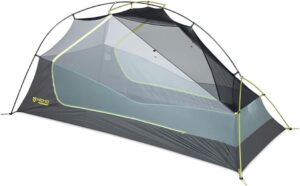
8. NEMO Dragonfly OSMO
We tested the NEMO Dragonfly OSMO along with the Hornet Elite OSMO during a 4-day hike through the Maroon Bells Loop. While both tents offer the premium quality that we expect from NEMO, they will appeal to two different categories of backpackers.
With 29.0 sq ft of floor space and 20.0 sq ft of combined vestibule space, the Dragonfly is more spacious than the Hornet Elite. While the peak height of 41 inches is great, the tapered floor plan reduces the effective inner space.
With a weight of 3 pounds 2 ounces, the Dragonfly the weight-to-space ratio is above average. However, if you’re counting each ounce for a solo trip, the Hornet Elite is a better choice.
The 10D nylon ripstop of the canopy offers decent tear resistance, and it feels more robust than the Hornet Elite. During one night when it rained heavily, water never seeped inside the tent through the OSMO fabric of the rainfly and floor. Both the mesh body of the tent and the rainfly offered adequate ventilation on warmer nights. Without a doubt, this is an excellent tent for use in warm and wet conditions.
The assembly is intuitive, and the pre-connected DAC Featherlite NFL poles are super easy to clip together using Jake’s Foot pole clips. Overall, the Dragonfly offers a secure shelter in moderately windy weather.
One thing I love about the Dragonfly is the ample storage space. From pockets at each side to a large mesh gear loft, stashing small and large items is never a problem in the tent.
Overall, the Dragonfly shines as a lightweight and comfortable tent. But it isn’t a budget-friendly option and is best chosen by serious backpackers.

9. Sea to Summit Telos TR2
The Sea to Summit Telos TR2 is a well-rounded tent that comes with an array of impressive practical features. This is a versatile tent, albeit at a premium price.
Here’s one example: the unique Tension Ridge design of the crossbar adds to the usable head-and-shoulder space. This makes a noticeable difference while sitting up in this tent.
With a weight of 3 lbs. 4.3 oz, the Telos is on par with the other freestanding competitors. The “FairShare” storage system allows you to pack the tent in three separate stuff sacks and split the load.
The floor area of 28 sq. ft and a peak height of 43.5 inches make the interiors feel roomy. The Telos has one of the tallest doors in this category, which adds to the convenience.
This tents floor and rain fly are made from the relatively delicate 20D and 15D ripstop nylon, respectively. It doesn’t come with a footprint, so watch out for sharp rocks and roots while pitching.
The DAC poles feel robust, and the quality of the hardware doesn’t raise any concerns. As a 3-season tent, the wind resistance and the weather protection offered by the Telos are great.
That said, water can pool near the tension ridge if it rains heavily. With dedicated top and bottom vents, the tent offers adequate ventilation, and I never faced issues with condensation.
Like typical freestanding tents, setup and take down are simple. Another great feature is the “Hang Out Mode”. By using trekking poles, the rainfly can be pitched on its own in sunny weather.
How to Choose the Best Backpacking Tent
With so many design varieties, choosing the best hiking or backpacking tent isn’t easy. Like most other gear-buying decisions, breaking down the key aspects will help you make the right choice.
Comfort
Comfort is subjective depending on individual preferences and circumstances. With tents, it is mostly about how spacious or cramped their interiors are, in other words, livability. With ultralight tents, the objective is to cut weight. So, expect minimal floor space and steeply tapered walls.
One effective camping tip is to choose a tent with slightly larger floor space than you actually need. In two-person tents, make sure that there is enough space to spread out two standard-width sleeping pads. Check the peak height to ensure that the space allows you to sit upright without hunching.
Weather Resistance
Generally, ultralight tents are less weather-resistant than heavier ones. Unless you pack for backpacking trips in winter, most 3-season tents can withstand occasional rain and thunderstorms. A full-coverage rain fly with waterproof coatings and sufficient guy-out points is another necessity.
But don’t expect 3-season tents to withstand strong wind gusts on a high Himalayan ridge. For warm conditions, pick a tent with good ventilation. For winter camping and ski touring, choose a 4-season tent that can handle heavy snow and strong winds.
Durability
As the weight of a tent goes down, so does its durability. 10D or 20D fabrics are great for weight savings, but are more prone to punctures and tears. 40D nylon fabrics are more durable but slightly heavier. With ultralight options, you may have to sacrifice durability.
Coming to tent poles, aluminum alloy or composite materials are the best choice. DAC (Dongah Aluminum Corp.) poles are a popular option as they are lightweight and flexible.
Remember that the floor of a tent sees the most action. So, a robust and puncture-resistant floor material is a better choice.
Weight
Shedding every ounce of extra weight is important for long-distance hikes. I remember carrying a super heavy backpack on a long desert trail a few years back. I ended up draining my hydration pack long before the next water source and almost got dehydrated. The good news is that even some of the premium ultralight tents can offer sufficient space and durability.
While weight is always going to be one of the most important factors in backpacking, the weight of the tent won’t matter if it lacks durability and weather resistance.
Ease of Setup
Your hiking experience depends a lot on whether a tent is easy to set up and take down. Backpacking tents with a freestanding design and pole hubs make the process of assembly easier. Semi-freestanding tents are lighter, but you may find the pitching to be fiddly. That said, it gets easier as you get used to the process.
Season Rating
The choice between 3-season and 4-season tents depends on the weather conditions you will face. Since most backpackers stick to trails during summer months, 3-season tents are a more popular choice.
These tents perform well when there are no prolonged periods of inclement weather and work well in spring and early fall as well. In contrast, 4-season tents are designed to handle heavy snow and strong winds. But, they aren’t ideal for warm weather.
Price and Value
Tents for backpacking come in a wide variety of prices, and spending more will get you lighter-weight and higher-end fabrics. If you’re going for a cheaper option, take a hard look at the overall quality and potential trade-offs. At the end of the day, you don’t want a cheap tent collapsing in a storm.
Interior Space
The interior space of a tent relates to comfort and weight. While one-person tents are the lightest, two-person models that can fit two standard-width sleeping pads are the most popular option. They allow you to share the space with a partner as needed. For small families or couples with a pet, a 3-person tent is the best choice.
Ventilation
Proper airflow within a tent prevents the interior from feeling stuffy. When the weather is warm and humid, ventilation minimizes condensation on the inner walls. A tent with breathable mesh in a double-walled structure and vents on the rainfly will ventilate well.
Storage
I am a big supporter of interior pockets in a tent – the more, the better. These are super helpful in keeping the floor clear of small items. While comparing tents, check the effective vestibule area. A larger vestibule area will help reduce the clutter.
Doors
Most 3-season tents come with dual doors that allow you to move out easily from both sides. Larger and wider doors make it easier to move into and out of the tent. Picking a tent with large doors also helps improve the ventilation.

Packaged Weight Vs Minimum Trail Weight
Both the packaged weight and the minimum weight of a tent are mentioned in the specifications. The former refers to the total weight of the tent, including all the accessories. The minimum weight is the combined weight of the three essential components. These are the tent body, the rainfly, and the poles.
The actual weight you pack depends on the number of tent components you decide to carry based on your backpacking checklist.
Do You Need a Footprint?
The answer depends on your preferences. A footprint will extend the life of the tent floor and serve as an additional layer of waterproofing and insulation. On the downside, it will add to the weight you will be carrying while hiking in the rain or snow. Then there is the question of packing and drying a wet footprint after rain.
The other aspect is price. Many tents don’t include a footprint, and you will have to buy one separately. Instead, you may prefer to buy a tent patch kit for emergency repairs, which is much cheaper.
Final Thoughts
That brings us to the end of our list of the best backpacking tents. While some of them have been marked as top performers, it’s best to match each tent with your individual preferences. Depending on your backpacking style, even a low-ranking tent might be a better match.
One last suggestion: While buying a tent, choose a retailer with a good return policy. That way, you won’t be stuck in a tent that doesn’t meet your requirements.


